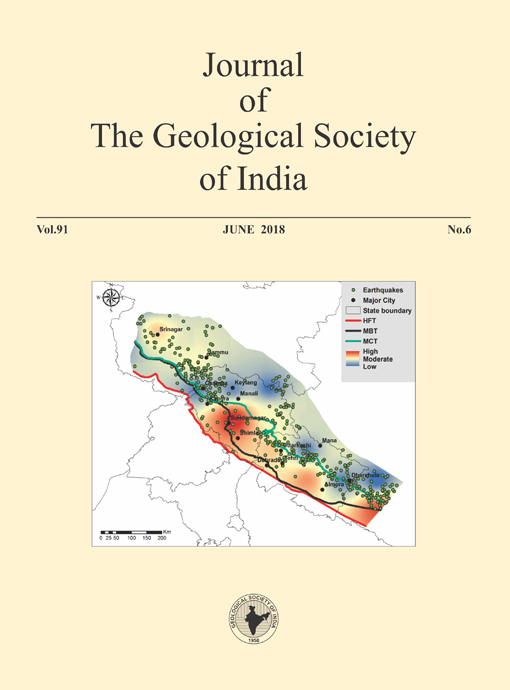Measurement of Radon Concentration in Drinking Water in Bhiwani District of Haryana
DOI:
https://doi.org/10.1007/s12594-018-0926-6Abstract
This investigation aims to evaluate the concentration of dissolved radon in drinking water and to assess the associated radiation doses for infants, children and adults in Bhiwani district of Haryana The radon concentrations were measured in 82 drinking water samples collected from 32 villages/towns in the Bhiwani district. The measurements were performed by RAD7, an electronic radon detector manufactured by Durridge Company Inc. The mean radon concentration ranged between 1.3 ± 0.4 and 13.4 ± 2.2 Bq l-1. The mean radon concentrations from two locations exceeded the maximum contamination level (MCL) of 11 Bq l-1 recommended by United States Environmental Protection Agency. The total annual effective doses due to ingestion and inhalation of radon in drinking water varied from 10.1 to 104.4 μSv y-1 for infants, 5.8 to 59.6 #956;Sv y-1 for children and 6.6 to 67.7 #956;Sv y-1 for adults and the average values were found to be 46.3, 26.5 and 30.1 #956;Sv y-1, respectively.Downloads
Metrics
Issue
Section
Downloads
Published
How to Cite
References
Ahmad, N., Jaafar, M.S. and Alsaffar, M.S. (2015) Study of radon concentration and toxic elements in drinking and irrigated water and its implications in Sungai Petani, Kedah, Malaysia. Jour. Radiat. Res. Appl. Sci., v.8, pp.294-299.
Ahmad, N., Rehman, J.U., Rafique, M. and Nasir, T. (2017) Age-dependent annual effective dose estimations of 226Ra, 232Th, 40K and 222Rn from drinking water in Baling, Malaysia. Water Sci. Tech: Water Supply, ws2017094. DOI: 10.2166/ws.2017.094
Central Ground Water Board (2012) Ministry of Water Resources, Government of India, Ground water information booklet Bhiwani district, Haryana, North Western Region, Chandigarh. <http://cgwb.gov.in/District_Profile/ Haryana/Bhiwani.Pdf>.
Chandrasekharam, D., Varun, C., Garg, G., Singh, H.K. and Trupti, G. (2014) High heat generating granites of Siwana, Rajasthan. GRC Trans., v.38, pp.625-628.
Duggal, V., Mehra, R. and Rani, A. (2013) Determination of 222Rn level in groundwater using a RAD7 detector in the Bathinda district of Punjab, India. Radiat. Prot. Dosim., v.156, pp.239-245.
Duggal, V., Sharma, S. and Mehra, R. (2017a) Radon levels in drinking water of Fatehabad dist., Haryana, India. Appld. Radiat. Isot., v.123, pp.36-40.
Duggal, V., Rani, A., Mehra, R., Saini, K. and Bajwa, B.S. (2017b) Assessment of age-dependent radiation dose and toxicity risk due to intake of uranium through the ingestion of groundwater from Northern Rajasthan, India. Toxicol. Environ. Chem., v.99, pp.516-524.
Durridge Radon Instrumentation (2016) RAD H2O User Manual, Radon in Water Accessory, Durridge Company Inc. < http://www.durridge.co.uk/ documentation/RAD%20H2O%20Manual.pdf>. Assessed 03-08-2016.
Eisenbud, M. and Gesell, T. (1997) Environmental Radioactivity from Natural, Industrial and Military Sources. 4th edn. Academic Press/Elsevier Inc, San Diego, CA, USA.
EU (1998) European drinking water directive 98/83/EC of 3rd November 1998 on the quality of water intended for human consumption. Official Journal of European Commission.
EU (2001) Commission recommendation of 20th December 2001 on the protection of the public against exposure to radon in drinking water. Official Journal of European Commission.
International Commission on Radiological Protection (1993) Protection against Radon-222 at home and at work. ICRP Publication 65 Annals of the ICRP, 23(2): Pergamon Press, Oxford.
Kochhar, N. (1983) Tusham ring complex, Bhiwani India. Indian National Sci. Acad., v.49, pp.459-490.
Kochhar, N. (1989) High producing granites of the Malani igneous suite Northern Peninsular, India. Indian Miner., v.43, pp.339-346.
Kochhar, N. (2000) Attributes and Significance of the A-type Malani Magmatism, Northwestern Peninsular India. In M.Deb (Ed.) Crustal evolution and metallogeny in the Northwestern Indian shield. Chapter 9, pp.158-188, Narosa Publishing House, New Delhi.
Mann, N., Kumar, A., Kumar, S. and Chauhan, R.P. (2017) Measurement of radium, thorium and potassium and associated hazard indices from the soil samples collected from Northern India. Indoor Built Environ., DOI: 10.1177/1420326X17696136.
Manzoor, F., Alaamer, A.S. and Tahir, S.N. (2008) Exposures to 222Rn from consumption of underground municipal water supplies in Pakistan. Radiat. Prot. Dosim., v.130, pp.392-396.
Rani, A., Mehra, R. and Duggal, V. (2013) Radon monitoring in groundwater samples from some areas of Northern Rajasthan, India, using a RAD7 detector. Radiat. Prot. Dosim., v.153, pp.496-501.
Sethy, N.K., Jha, V.N., Ravi, P.M. and Tripathi, R.M. (2015) Assessment of human exposure to dissolved radon in groundwater around the uranium industry of Jaduguda, Jharkhand, India. Curr. Sci., v.109, pp.1855-1860.
Sharma, S., Duggal, V., Srivastava, A.K. and Mehra, R. (2017a) Assessment of radiation dose from exposure to radon in drinking water from Western Haryana, India. Internat. Jour. Environ. Res., v.11, pp.141-147.
Sharma, S., Duggal, V., Srivastava, A.K., Mehra, R. and Rani, A. (2017b) Radon concentration in groundwater and associated effective dose assessment in Western Haryana, India. Internat. Jour. Inn. Res. Sci. Engg., v.3, pp.69-78.
United Nations Scientific Committee on the Effects of Atomic Radiations (2000) Sources, effects and risks of ionizing radiation. UN, New York.
United States Environmental Protection Agency (1991) Federal Register 40 Parts 141 and 142: National Primary Drinking Water Regulations; Radionuclides: proposed Rule. U.S. Government Printing Office.
Wang, X., Li, Y., Du, J. and Zhou, X. (2014) Correlation between radon in soil gas and the activity of seismogenic faults in the Tangshan area, North China. Radiat. Meas., v.60, pp.8-14.
World Health Organization (1988) Guidelines for Drinking-Water Quality, Vol. 1. World Health Organization Publication, p.197.
World Health Organization (2008) Guidelines for Drinking-Water Quality, Vol. 1. Recommendations, 3rd edn. World Health Organization, Geneva.
World Health Organization (2009) Handbook on indoor radon, a public health perspective. World Health Organization, Geneva.
Yakut, H., Tabar, E., Zenginerler, Z., Demirci, N. and Ertugral, F. (2013) Measurement of 222Rn concentration in drinking water in Sakarya, Turkey. Radiat. Prot. Dosim., v.157, pp.397-406.

 Vikas Duggal
Vikas Duggal






